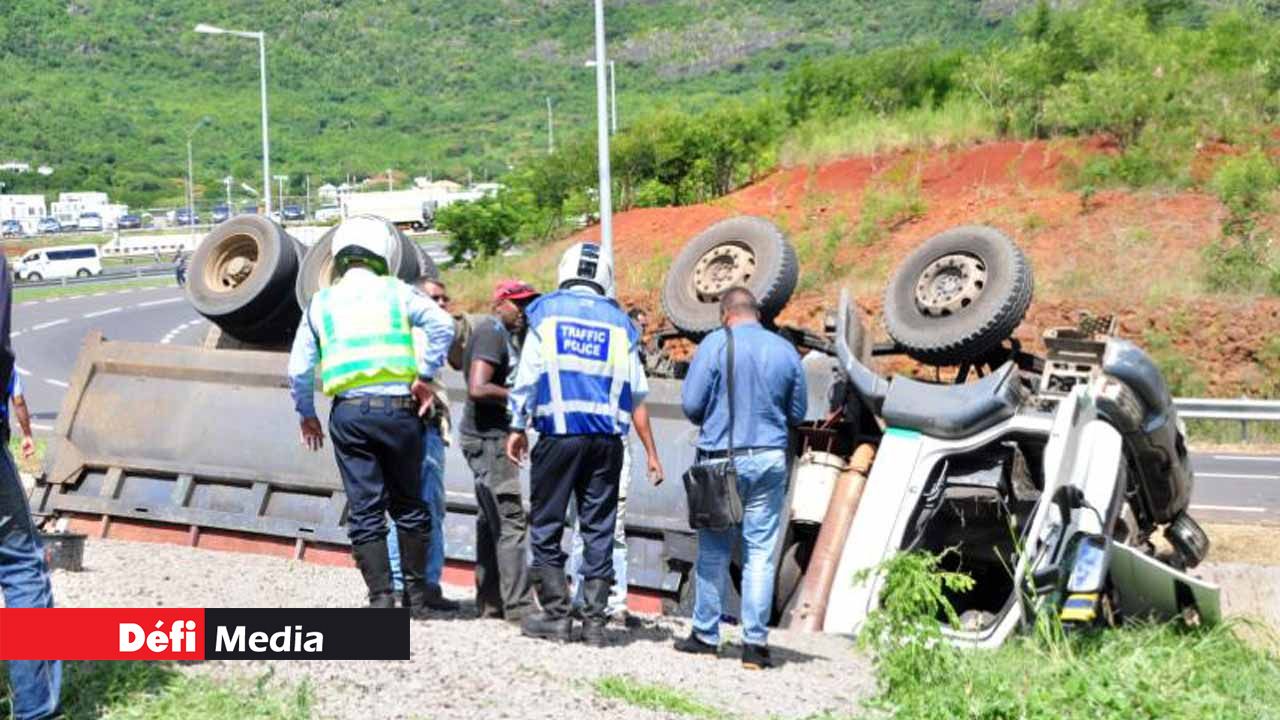
37 persons lost their lives since the beginning of this year in fatal accidents. An alarming situation that is worrying the relevant authorities. What are the causes of these fatal accidents? How to reduce them? According to statistics, young persons are more at risk with a higher number of victims. What explains this increasing trend?
Since January, the number of accidents has kept on increasing. Pedestrians and drivers are losing their lives almost every day. Since January, 25 men and 12 women died in fatal accidents. Among the victims, there were two adolescents aged less than 15. There were 11 young people between the age of 16 to 25, seven adults aged between 26 and 50, nine aged between 51 and 59 and eight aged 60 and above. Recent statistics show that 11 pedestrians, five drivers, seven motorcyclists, nine bus passengers, two cyclists and three pillion riders died during accidents since the beginning of the year.
Alain Jeannot, Founder of the NGO ‘Prevention Routière Avant Tout’ reveals that humans are naturally programmed to walk at an average speed of 5 km/hr or run at around 14 km/hr. “At these speeds, whenever collisions happened, they rarely had serious implications. Casualties from road accidents started with horses as a means of transport, which increased the speed at which he could move around. Then, with the invention of powerful motor vehicles, more serious collisions increased. This dimension should be given due consideration as speed is not only one of the leading causes of death but is also an aggravating one and it is directly linked to the motor vehicle. You don’t get serious accidents in a country which has a fleet of 100 ox carts and 50 bicycles.”
For him, Mauritius is home to more than 500,000 motor vehicles of which 40 per cent are two wheelers which are 25 times more at risk during collisions. “Our fatality rate is 11.4 per 100,000 inhabitants. The situation is worrying.”
In Germany in 2012, there were 44 traffic related deaths per one million inhabitants, people could drive over 200 mph on public roads, there were tons of bikers, and there were lots of additional traffic from other countries passing through because of Germany's central location in Europe.
Measures to be introduced
Road safety culture
Alain Jeannot explains that road users should adopt a road safety culture which starts with giving priority to Respect and Care while on the road. “The road user should bear in mind that the space he is using to circulate is a public one and is potentially dangerous. He should start by respecting his own life and that of others with whom he shares the road. Indiscipline and non compliance to road traffic regulations are still cause for concern. For instance, a road traffic contravention is recorded by the police every two minutes. Imagine what could be the real amount of infractions that go unpunished!”

More campaigns
Both CI Mohit Ramah and Alain Jeannot believe that increasing awareness among drivers is important. “It is important to encourage the use of light clothing or reflective accessories by vulnerable road users like pedestrians and cyclists at night. As well as increasing sensitisation programs in schools and media and discourage the use of two wheelers as a means of transport,” says Alain Jeannot. On his part, CI Mohit Ramah states that police has already increased the number of breath tests. “During week-end and early mornings, we carry out a higher number of alcohol analyser tests. It has been observed that more young people drink drive early morning. Places near pubs are targeted. The penalties for these fines have been increased since December. If a driver is caught drunk for the first time, he will be fined between Rs 25 000 and Rs 50 000, as well as a maximum of five years. For the second fine, the fine ranges from Rs 50 000 and Rs 75 000 and subject to imprisonment of not less than 12 month and not more than eight years. Those found guilty can have their license suspended for 12 months (first found guilty) or even 24 months (second offence).
Infrastructure
Alain Jeannot adds that it is essential to create more infrastructures for pedestrians, especially in risky places like on motorways or highly affected areas like the region of Arsenal and Terre Rouge.
Probationary driving license
Alain Jeannot believes that there should be a probationary driving license program for those who are freshly qualified to drive on their own. Such programs exist in almost all developed countries. “They imply, for instance, a zero alcohol tolerance and a lower speed limit for drivers during the probation period. Authorities might also underpin the importance of respect and human relationship by introducing a module about same in driving tests.”
 Sensitisation campaign on tyre safety launched
Sensitisation campaign on tyre safety launched
A Road Safety Campaign on Tyres was launched to sensitise drivers and owners of vehicles on tyre related road safety aspects. This campaign is an initiative of the Ministry of Public Infrastructure and Land Transport in collaboration with the Traffic Management and Road Safety Unit and the Mauritius Police Force.
The theme of this latest road safety campaign is ‘Pa perdi ou lavi akoz enn larou’ - Don’t lose your life because of a tyre. It focuses on the importance of maintaining tyres in good condition at all times to improve road safety. Tyres are the only part of vehicle in contact with the road, and their quality and conditions are critical in the safety and stability of the vehicle.
Pamphlets will thus be distributed across the country to raise awareness of drivers on tyre safety behaviour and encourage them to pay necessary attention to the status of their own vehicles’ tyres. The pamphlets include several guidelines namely that drivers should maintain proper tyre inflation which is essential for both fuel efficiency and better tyre performance by checking the inflation pressure regularly. Also, tyres should be replaced when there is any sign of deterioration such as sidewall cracking, carcass deformation, and tread wear-out. Tyres of the correct specification should moreover be fitted to the relevant vehicles while tyre pressures across an axle should be equal.
Drivers will therefore be able to make the correct assessment in relation to the tyre condition through the technical elements of inflation pressure, tread depth, damage, and age. Following the launch of the campaign, the Police will be adopting a zero tolerance policy and will be strictly enforcing traffic regulations related to the use of defective, bald and worn tyres.
The latest campaign is part of the communication strategy, ‘Nou sekirite avan tou’ – Our safety first and foremost, of the Ministry of Public Infrastructure and Land Transport with the collaboration of the Mauritius Police Force and various stakeholders to help change attitudes and behaviour, and save lives on the road. The strategy kicked off last year with a National Road Safety Month and along with several other awareness campaigns targeting the most vulnerable road users namely pedestrians and motorcycle riders.
 Manoj Raj Kumar: “Psychological testing should be introduced”
Manoj Raj Kumar: “Psychological testing should be introduced”
The secretary of the Approved Driving Instructor Association, Mr Manoj Raj Kumar, explains that one of the major questions regarding road accidents is the validity of our driving test system. “Following an oral examination, future drivers take driving courses for around five months before going for their driving test. We, as school driving instructors, follow the syllabus established by the police and the relevant authority. We also teach our students defensive driving in order to help them avoid accidents in the future. However, once they pass the driving test, there is no follow-up with those new drivers,” explains Manoj Raj Kumar.
The driving instructor confides that some new drivers are aware of the dangers on the road and the precautions they should take while others would drive carelessly once they get their driving licence.
The Secretary of the Approved Driving Instructor Association believes that there are no shortcomings in the driving lessons given by driving schools. “I trust that instructors are delivering on the job. I do not believe that it is our drivers who do not know how to drive. For example, when we say that there are 150 fatal accidents, this does not necessarily mean that 150 vehicles were involved in it. Also when we say that there are like 400 serious accidents, where compared with the number of vehicles that are on our roads, this represent 1% or less vehicles involved in these accidents.”
However, Manoj Raj Kumar deplores that long time drivers also infringe road traffic regulations. Many are seen on their mobile phone while driving, or they drive using only one hand. I trust that driving licence test should include a course with a psychologist. They will educate drivers on appropriate behaviours and mindset. Driving instructors are not really trained to do this.”
Questions on haphazard situations should also be included in the oral test and that drivers should come to court in person to pay their fines. “Those who have breach road traffic regulations or are reckless drivers should do community work.”
Raj Mootoosamy – Victims Support Mauritius: “Mindsets should change”
“Unfortunately, we notice an increase rather than a regression in the number of fatal accidents,” utters Raj Motoosamy. This member of the Victim Support Mauritius association states that there are several families who suffer because they lost their loved ones in road accidents. “It is high time that mentalities and mindsets change for the better of our society. Indeed despite police patrols, breath analyser tests among others, drivers are still careless on the road. I trust that the issue should be tackled at its roots.”
Raj Motoosamy explains that new drivers are not usually involved in road accidents but they are usually the cause of many accidents. “I believe that the driving test system should be revamped. For example, learner drivers are not learning how to drive in situations such as heavy rain, night time, when they are fogs, when there is huge traffic jams among others. They are not trained to drive in these dangerous situations and they are thus not ready to face them.”
He believes that measures should be taken to upgrade motorcycle driving tests. “In addition, both car drivers and motorcycle riders should go through a routine test every two or three years. It’s all talk and no action at the moment. I trust that a round table should be organised with all stakeholders in order to look out for appropriate solutions. Police officers should also give feedback on their observations.”
Raj Motoosamy however deplores the attitude of decision-makers. “There is no doubt that they are doing their job but their approach is questionnable. For example, the way the police interacts with the public. Developing and projecting a better image would be good for both the police and the public.”
Raj Motoosamy believes that the government should come up with a support group in order to support victims. “I know cases where the sole bread winner of a family lost his life in a road accident. His family is left on their own. These families often do not have the means to seek judicial redress. So, I trust that an official support group would be of great help.”
Factors causing accidents
Chief Inspector (CI) Mohit Ramah and Alain Jeannot list a series of factors causing accidents.
Infrastructure
Alain Jeannot explains that absence of road infrastructure of the low maintenance of same can provoke road accidents.
Vehicle
Both CI Mohit Ramah and Alain Jeannot reveal that the condition of a vehicle plays a vital role and it is the responsibility of the driver to check their vehicle before starting their journey. “Defective components like used brake pads or defective lights at night may lead to collisions.”
Road Users
Alain Jeannot argues that more importantly, the behaviour of the road user is crucial in the creation or prevention of collisions. “The main factors affecting the behaviour of the road user are: influence of alcohol and drugs, speeding, fatigue, ignorance or non compliance to road traffic regulations, lack of visibility at night and distraction.” Similarly, CI Mohit Ramah argues that drivers are careless and indiscipline. “Speeding is often seen as a major cause of accidents. Motorcyclists are more vulnerable because they ride at a high speed and hence, the probability for them to collide is more. During rainfall, drivers have a tendency to drive at the same speed as during sunny day. They do not take necessary precautions when the road is slippery.”
Drink driving
According to CI Mohit Ramah, for the period starting from 8th December 2016 till 31 March 2017, 441 persons were caught driving after having consumed alcoholic drinks. “As we see drivers are still taking risks by drink driving. Some of them are speeding at the same time, which makes them more at risk of an accident.”

Notre service WhatsApp. Vous êtes témoins d`un événement d`actualité ou d`une scène insolite? Envoyez-nous vos photos ou vidéos sur le 5 259 82 00 !





















![[Info Soirée] : « Sofer la ti sou, 70 mg lalkol dan so disan»](https://files.defimedia.info/sites/default/files/styles/square_thumbnail/public/thumbnail-211225.jpg?itok=2s9EwxMT)
